TOURIST ATTRACTION

Situated in the interiors of West Bengal, Malda has history at every turn and every corner. The district is characterised by its great archaeological relics such as Mourya Empire, Gupta Dynasty and Pala Dynasty.
Adorned with monuments from the time of the pre-colonial Nawabs to the East India Company, Malda is a destination where one can feel the glorious past of Bengal.
Explore Malda, the land of History....

The Lakhchhipi Darwaza or Lukochuri Gate is located to the south-east of the Kadam Rasool Mosque. Shah Shuja is said to have built it in 1655 in the Mughal architectural style. The name originated from the royal game of hide-and-seek that the Sultan used to play with his begums.
According to another school of historians, it was built by Allauddin Hussein Shah in 1522. This double-storeyed Darwaza functionally acted as the main gateway to the palace.
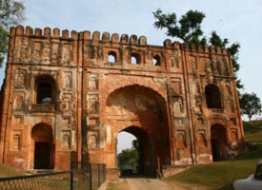
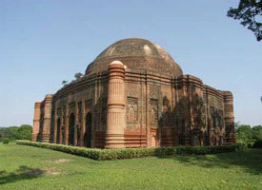

Legend attributes the building of this mosque to a dancing girl of the royal court. It was built in 1475. Traces of intricate 'mina' work in blue, green, yellow, violet and white on the enamelled bricks lining the outer and inner walls are still visible. The splendour of colours has also led to the Mosque being called the Painted Mosque. Another interesting feature of this mosque is its arched roof, supported by octagonal pillars.

Adina Mosque, built in 1369 by Sultan Sikander Shah, is one of the largest mosques in India. It also typifies the most developed mosque architecture of the period, the orthodox design being based on the great 8th century mosque of Damascus. Carved basalt masonry is used to support the 88 brick arches and 378 identical small domes.
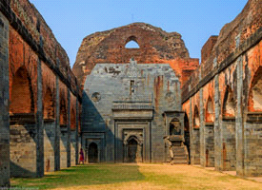
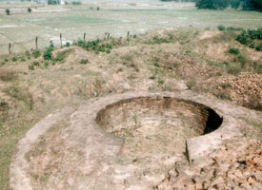

Jagjibanpur is situated about 30 km from Malda town, towards the south east of Habibpur ruin of a Buddhist Monastery (9th Century AD) exists there with copper plates with inscriptions. The plate contains inscription on both sides in Siddhamartika script. It has a royal seal attached to the top containing the dharmachakra flanked by two deer and an inscription in Sanskrit reading 'Srimahendrapaldevah'.
Five mounds (locally called Bhita or Danga) were identified, which were the Tula Bhita or Salai Danga, Akhari Danga, Nim Danga, Mai Bhita and Laksmi Dhipi. Apart from these there were several other minor mounds.

12 km south of Malda, right on the Indo-Bangladesh border, is one of the most important historical places of 14th and 15th century Bengal. It has immense value from the archaeological point of view. The relics that are particularly worthseeing are the Bara Sona Mosque aka Boro Sona Mosque aka Baro Duari Mosque, Dakhil Darwaja aka Salami Darwaja (built in 1425), Qadam Rasul Mosque and the ruins of the extensive fortification. There are colorful enamelled tiles on the Gomti Gate and Firoz Minar.
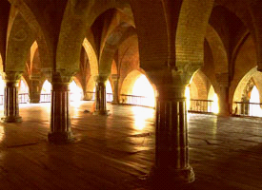
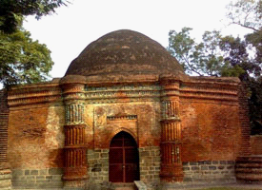

Standing to the northeast of the Chika Mosque, the Gumti Darwaza was built in 1512 by Allauddin Hussein Shah. Made of brick and terracotta, the once brilliant colours woven into the artwork are still partly visible. It is said that real gold was used in the decorations.

A small temple constructed under the Kadam tree contains Sri Chaitanya's footprints on stone. Every year, on the Jaishthya Sankranti (14-15 June), celebrations are held here to commemorate the arrival of Sri Chaitanya. A week-long fair also starts on this day. Vaishnav devotees from all over India gather here at this time where ritualistic songs are performed. A village fair, with local produces, is held for three days which continues for a couple of days more after the celebrations are completed. The local feel of rural Bengal is abundant and thrilling.
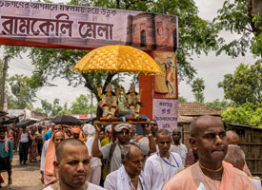
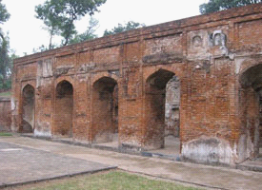

Half a kilometre away from the Feroze Minar, built in 1530. Kadam Rasool means 'Footprints of the Prophet'. The mosque contains the footprints of Hazrat Muhammad on stone. On the four corners there are four towers made of black marble.
Opposite the Kadam Rasool Mosque stands the 17th century tomb of Fateh Khan, a commander of Aurangzeb's army. This interesting structure was built in the Hindu aat chala style.

Chika Mosque was built under the patronage of Sultan Yusuf Shah in 1475. The mosque was named Chika because it was a guarded refuge of bats, locally called Chikas. The mosque features a single-domed edifice, which has almost been turned into ruins.
However, the tourists can view the carvings on the walls and the figures of the Hindu deities on the stonework of doors and lintels, which are partly visible. The structure is unique as it also has traces of the architectural style of the Hindu Temples.
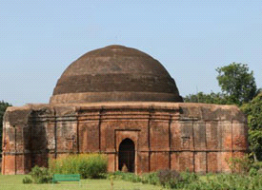
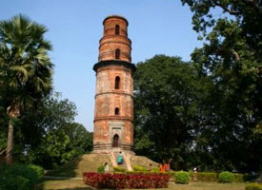

Firoz or Firoza Minar (Blue Tower) is 25.60 m high with spiral staircase having 73 steps was probably constructed by Saifuddin Firoz an Abyssinian commander of the royal forces who became the Sultan by avenging the killing of Sultan Jalaluddin Fath Shah, the last ruler of the Iliyas Shahi dynasty. From the foot of the door, the tower rises in three storeys of twelve sides, each storey demarcated by ornamental bands. The fourth and fifth storeys are circular with reduced diameter. The last storey originally an open arched room covered by a dome has been changed into an open flat roof by some restorer. This is considered as a victory tower as its builder is credited with many victories in battles.